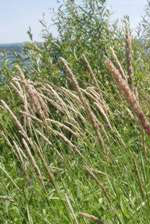Threats to Birds - Common Reed (Phragmites australis)
Overview
Common reed is found in all states in the contiguous U.S. and thrives in disturbed or pristine wetland habitat in freshwater and brackish tidal wetlands. Both native and introduced genotypes from the Old World exist in North America. The introduced genotype of the common reed is particularly invasive in the eastern states along the Atlantic Coast. Common reed has been used in many wetland rehabilitation and stabilization projects. It can develop dense stands of highly-combustible materials during the dormant season, which can increase fire hazard, conceal vistas and natural landscapes, retain pools of water that become mosquito-breeding areas, and result in hydrologic disturbance such as tidal restriction. At the Wertheim NWR, NY, which is a crucial stopover site for migrating shorebirds, raptors and songbirds, it out-competes native marsh species and makes impenetrable stands which are useless to waterfowl. Common reed has infested and degraded greater than half of this marsh.
Description
Common reed has woody hollow culms which can grow up to 6 meters high. It forms dense stands and is long-lived. It can reproduce by seeds, but primarily spreads through rhizomes. Leaves are lanceolate, 20-40 cm long. Flowers develop by mid summer and are arranged in tawny spikelets with many tufts of silky hair.
Birds Affected
American Black Duck and other waterfowl; Costa’s Hummingbird; Seaside Sparrow; Abert’s Towhee; Elf Owl; Curve-billed Thrasher.
Control
Cultural, mechanical and/or chemical methods can be used. Prescribed burning does not reduce the growing ability unless root burn occurs. Prescribed burning after chemical treatment has been used with some success at some wildlife refuges. Grazing, dredging, draining and cutting are other methods that have been used to reduce vigor. However, these methods may not be appropriate on preserves. Biological control does not appear to be an option at this time. |
